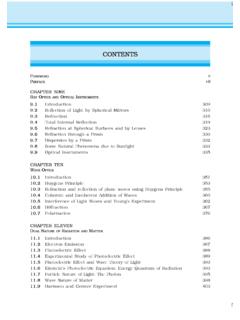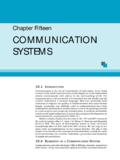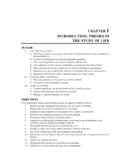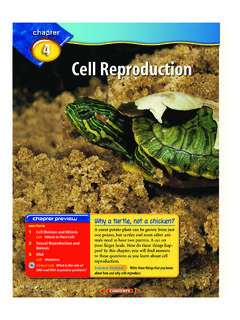Transcription of organisms die without fail, species continue to live ...
1 Biology in essence is the story of life on earth. While individualorganisms die without fail , species continue to live throughmillions of years unless threatened by natural or anthropogenicextinction. Reproduction becomes a vital process withoutwhich species cannot survive for long. Each individual leavesits progeny by asexual or sexual means. Sexual mode ofreproduction enables creation of new variants, so that survivaladvantage is enhanced. This unit examines the generalprinciples underlying reproductive processes in living organismsand then explains the details of this process in flowering plantsand humans as easy to relate representative examples.
2 A relatedperspective on human reproductive health and howreproductive ill health can be avoided is also presented tocomplete our understanding of biology of 1 Reproduction in OrganismsChapter 2 Sexual Reproduction inflowering PlantsChapter 3 Human ReproductionChapter 4 Reproductive HealthPANCHANAN MAHESHWARI(1904-1966)Born in November 1904 in Jaipur (Rajasthan) Panchanan Maheshwarirose to become one of the most distinguished botanists not only of Indiabut of the entire world. He moved to Allahabad for higher educationwhere he obtained his During his college days, he was inspiredby Dr W.
3 Dudgeon, an American missionary teacher, to develop interestin Botany and especially morphology. His teacher once expressed thatif his student progresses ahead of him, it will give him a great words encouraged Panchanan to enquire what he could do forhis teacher in worked on embryological aspects and popularised the use ofembryological chracters in taxonomy. He established the Departmentof Botany, University of Delhi as an important centre of research inembryology and tissue culture. He also emphasised the need for initiationof work on artificial culture of immature embryos.
4 These days, tissueculture has become a landmark in science. His work on test tubefertilisation and intra-ovarian pollination won worldwide was honoured with fellowship of Royal Society of London (FRS),Indian National Science Academy and several other institutions ofexcellence. He encouraged general education and made a significantcontribution to school education by his leadership in bringing out thevery first textbooks of Biology for Higher Secondary Schools publishedby NCERT in and every organism can live only for a certain periodof time.
5 The period from birth to the natural death of anorganism represents its life span. Life spans of a feworganisms are given in Figure Several other organismsare drawn for which you should find out their life spansand write in the spaces provided. Examine the life spansof organisms represented in the Figure Isn t it bothinteresting and intriguing to note that it may be as shortas a few days or as long as a few thousand years? Betweenthese two extremes are the life spans of most other livingorganisms. You may note that life spans of organisms arenot necessarily correlated with their sizes; the sizes ofcrows and parrots are not very different yet their life spansshow a wide difference.
6 Similarly, a mango tree has a muchshorter life span as compared to a peepal tree. Whateverbe the life span, death of every individual organism is acertainty, , no individual is immortal, except single-celledorganisms. Why do we say there is no natural death insingle-celled organisms ? Given this reality, have you everwondered how vast number of plant and animal specieshave existed on earth for several thousands of years? Theremust be some processes in living organisms that ensurethis continuity. Yes, we are talking about reproduction,something that we take for 1 REPRODUCTION IN SexualReproduction4 BIOLOGYF igure Approximate life spans of some organisms45 REPRODUCTION IN ORGANISMSR eproduction is defined as a biological process in which anorganism gives rise to young ones (offspring) similar to itself.
7 The offspringgrow, mature and in turn produce new offspring. Thus, there is a cycleof birth, growth and death. Reproduction enables the continuity of thespecies, generation after generation. You will study later in Chapter 5(Principles of Inheritance and Variation) how genetic variation is createdand inherited during is a large diversity in the biological world and each organismhas evolved its own mechanism to multiply and produce organism s habitat, its internal physiology and several other factorsare collectively responsible for how it reproduces. Based on whetherthere is participation of one organism or two in the process ofreproduction, it is of two types.
8 When offspring is produced by a singleparent with or without the involvement of gamete formation, thereproduction is asexual. When two parents (opposite sex) participate inthe reproductive process and also involve fusion of male and femalegametes, it is called sexual ASEXUAL REPRODUCTIONIn this method, a single individual (parent) is capable of producingoffspring. As a result, the offspring that are produced are not onlyidentical to one another but are also exact copies of their these offspring likely to be genetically identical or different?The term clone is used to describe such morphologically andgenetically similar division in unicellular organism: (a) Budding inyeast; (b) Binary fission in Amoeba(b)(a)Let us see how widespread asexual reproduction is, among differentgroups of organisms .
9 Asexual reproduction is common amongsingle-celled organisms , and in plants and animals with relatively simpleorganisations. In Protists and Monerans, the organism or the parentcell divides into two to give rise to new individuals ( ). Thus,6 BIOLOGYin these organisms cell division is itself a mode of reproduction. Manysingle-celled organisms reproduce by binary fission, where a cell dividesinto two halves and each rapidly grows into an adult ( , Amoeba,Paramecium). In yeast, the division is unequal and small buds areproduced that remain attached initially to the parent cell which,eventually gets separated and mature into new yeast organisms (cells).
10 Members of the Kingdom Fungi and simple plants such as algaereproduce through special asexual reproductive structures (Figure ).The most common of these structures are zoospores that usually aremicroscopic motile structures. Other common asexual reproductivestructures are conidia (Penicillium), buds (Hydra) and gemmules (sponge). reproductive structures: (a) Zoospores of chlamydomonas; (b) Conidia ofPenicillium; (c) Buds in Hydra; (d) Gemmules in sponge(d)(a)(b)(c)7 REPRODUCTION IN ORGANISMSYou have learnt about vegetative reproduction in plants in Class do you think Is vegetative reproduction also a type of asexualreproduction?


















